On the occasion of the day of the Italian Federation of Friends of Museums, a copy of Caesar’s Triumphs purchased and restored by the museum will be on view to the public as a preview from Sunday, October 3, within the usual visiting itinerary and with the full ticket of theDucal Palace in Mantua. The work will be temporarily displayed on the main floor of the Castle of San Giorgio.
“At the Ducal Palace about a year ago,” says the director of the Ducal Palace of Mantua Stefano L’Occaso, "we received reports that a copy of the Triumphs was passing through the Export Office. Fortunately, we were able to detain it, getting it to Mantua. It was a direct negotiation with the owner, represented by Simonetta Frascione. After the purchase, the painting underwent immediate restoration, directed by Daniela Marzia Mazzaglia and carried out by Nicoletta Garattini (Brescia). I thank both of them for their valuable work and am very happy to be able to enrich the palace’s collections with this additional important piece. Even if the quality of the copy is not sublime, it constitutes a historical and artistic document of extraordinary importance, because it is referable to a dramatic and crucial moment of the Gonzaga’s vicissitudes."
In 1492 Francesco II Gonzaga considered three to be the greatest masterpieces of Andrea Mantegna, court painter to the Gonzagas: the chapel created in the Castle of San Giorgio, no longer extant, and, like the Bridal Chamber, the Triumphs of Caesar: nine large canvases that, placed in sequence, constituted an extraordinary parade of images, a celebration of the military virtues of Julius Caesar and thus an allegory of the Gonzagas themselves. This cycle left Mantua for Venice in the spring of 1628 and from there came to London. Known and celebrated throughout the world, these masterpieces elevated the palace of Charles I of England to the rank of the courts of Paris and Madrid in terms of wealth and quality of art treasures.
In a 1629 letter, the merchant Daniel Nijs, mediator and architect of the sale, claimed to have concluded the transaction “for 68 thousand scudi” and reiterated that this was done “with great stupor of all Italy et disgusto estremo delli habitatori della città di Mantova.” Despite economic straits, the Gonzaga did not initially want to sell the Trionfi di Cesare, but were forced by circumstances to include them in a second lot, the sale of which was finalized in 1628, a year after the first sale of the picture gallery.
Before shipping the originals by ship to England (they are still preserved in the Orangery at Hampton Court), Nijs made 1:1 copies, intended to fill the void left in the Ducal Palace in Mantua. There has been no news of these copies for centuries, while smaller painted, drawn or engraved ones are known. In 1900, at an auction sale of the Cernazai collection in Udine, the existence of two copies of the same size as the originals was discovered. Renowned scholar Andrew Martindale surmised they were the copies made by Daniel Nijs at the time of the sale to Charles I Stuart. In 2005, however, no less than four canvases the size of the originals were made known and are preserved in the Alte Galerie in Graz. Compared to these four, the two Cernazai canvases are iconographically complementary: it is therefore possible that they were all part of the series made by Nys in 1628-1629.
Pictured is the copy of Caesar’s Triumphs before restoration (left) and after restoration (right).
 |
| Mantua's Ducal Palace buys and restores copy of Caesar's Triumphs: it will be previewed on display |
Warning: the translation into English of the original Italian article was created using automatic tools. We undertake to review all articles, but we do not guarantee the total absence of inaccuracies in the translation due to the program. You can find the original by clicking on the ITA button. If you find any mistake,please contact us.